Analysis of Flow Characteristic of Transonic Tandem Rotor Airfoil and Its Optimization
Abstract
:Featured Application
Abstract
1. Introduction
2. Numerical Simulation Method
2.1. Geometric and Aerodynamic Parameters
2.2. Geometric Model Setup
2.3. Computational Grid
2.4. Boundary Condition
- Unique Incidence
- Positive Incidence
3. Analysis of Aerodynamic Characteristics of the Basic Tandem Blade
3.1. Flow Characteristic of Basic Tandem Blade Overview
3.2. Loss Mechanism of the Tandem Blade in Typical Operating Conditions
- DE point
- NS point
4. Optimal Design of the Tandem Blades
4.1. The Optimization Procedure
4.1.1. Adjustment to Reduce the Loss at the DE Point
- FB
- AB
4.1.2. Adjustment to Increase the Incidence Range
- FB
- AB
4.2. Comparison of the Geometries Between Basic and Optimization Scheme
- Solidity ratio (σFB/σAB)—the solidity ratio was decreased from 1.6:1 to 1:1 to achieve a higher incidence range and the total equivalent chord length remained constant;
- FB camber line distribution—the camber before the 60% chord length was increased to suppress the shock intensity near the FB pressure side;
- AB camber line distribution—the camber before the 40% chord length was decreased to suppress the shock intensity on the AB suction side;
- AB inlet metal angle—the AB inlet metal angle was decreased by 1.5° to adapt to the FB outflow direction.
4.3. Comparison of the Blade Performance between the Basic and Optimization Scheme
5. Conclusions
- With an inflow Mach number of 1.2, the total pressure loss is difficult to control because of the complicated flow structures at the DE point; there is an obvious double-shock wave structure located rearward in the FB passage and a normal shock on the AB suction side. The complicated shock waves cause a strong interaction between FB and AB, and a different optimization strategy compared to conventional blade.
- The FB loss dominates the overall loss in all of the operating conditions. It exceeds 50% of the total loss at the DE point, and accounts for more than 80% at the NS point. Therefore, the optimization aiming at FB is of decisive significance to improve the blade performance.
- The conventional supersonic airfoil is not the optimum choice for the supersonic tandem blade due to the aerodynamic interaction between FB and AB. In this paper, the tandem blade was optimized considering this aerodynamic interaction by controlling the FB passage shock intensity near the pressure side, the AB shock intensity near the suction side, and the AB incidence. The numerical simulation results of the optimization scheme show that the total pressure loss declines by 20% at the DE point and the incidence range increases by about 0.5°.
Author Contributions
Funding
Acknowledgments
Conflicts of Interest
References
- Biollo, R.; Benini, E. Recent advances in transonic axial compressor aerodynamics. Prog. Aerosp. Sci. 2013, 56, 1–18. [Google Scholar] [CrossRef]
- Sulam, D.H.; Keenan, M.J.; Flynn, J.T. Single-Stage Experimental Evaluation of Highly-Loaded High-Mach-Number Compressor Stages Part 2: Data and Performance Multiple-Circular-arc Rotor. Available online: https://core.ac.uk/download/pdf/80656364.pdf (accessed on 1 July 2020).
- Brent, J.A.; Clemmons, D.R. Single-Stage Experimental Evaluation of Tandem-Airfoil Rotor and Stator Blading for Compressors Part 8: Final Report; NASA Center for Aerospace Information: Hanover, MD, USA, 1974; NASA-CR-134713.
- Bammert, K.; Beelte, H. Investigation of an axial flow compressor with tandem cascade. J. Eng. Power 1980, 102, 971. [Google Scholar] [CrossRef]
- Bammert, K.; Staude, R. Optimization for Rotor Blades of Tandem Design for Axial Flow Compressors. J. Eng. Power. 1980, 102, 369. [Google Scholar] [CrossRef]
- Wennerstrom, A.J. Highly loaded axial flow compressors: History and current developments. J. Turbomach. 1990, 112, 567–578. [Google Scholar] [CrossRef]
- Nezym, V.Y.; Polupan, G.P. A New Statistical-Based Correlation for the Compressor Tandem Cascade Parameters Effects on the Loss Coefficient. In Proceedings of the ASME Turbo Expo, Montreal, QC, Canada, 14 May 2007. GT2007-27245. [Google Scholar]
- McGlumphy, J.; Ng, W.-F. Numerical Investigation of Tandem Airfoils for Subsonic Axial-flow Compressor Blades. J. Turbomach. 2009, 131, 021018. [Google Scholar] [CrossRef]
- Hoeger, M.; Baier, D. High Turning Compressor Tandem Cascade for High Subsonic Flows, Part1: Aerodynamic Design. In Proceedings of the AIAA, San Diego, CA, USA, 31 July 2011. GT2011-5602. [Google Scholar]
- Hoeger, M.; Baier, D. High Turning Compressor Tandem Cascade for High Subsonic Flows, Part2: Numerical and Experimental Investigations. In Proceedings of the AIAA, San Diego, CA, USA, 31 July 2011. GT2011-5602. [Google Scholar]
- Liu, B.J.; Du, F. Development of a Preliminary Design Method for Subsonic Splittered Blades in Highly Loaded Axial-Flow Compressors. Appl. Sci. 2017, 7, 283. [Google Scholar] [CrossRef] [Green Version]
- Nehad, A.S.; Asiful, H.S. Natural convection of bio-nanofluid between two vertical parallel plates with damped shear and thermal flux. J. Mol. Liq. 2019, 296, 111575. [Google Scholar]
- Basma, S.; Ganesh, K. Slip flow and radiative heat transfer behavior of Titanium alloy and ferromagnetic nanoparticles along with suspension of dusty fluid. Microsyst. Technol. 2019, 290, 111223. [Google Scholar]
- Samuel, O.A.; Onanaye, A.S. Evaluation of heat irreversibility in couple stress falling liquid films along heated inclined substrate. J. Clean. Prod. 2019, 239, 117608. [Google Scholar]
- Schlaps, R.C.; Shahpar, S. Automatic Three-Dimensional Optimization of a Modern Tandem Compressor Vane. In Proceedings of the ASME Turbo Expo, Düsseldorf, Germany, 16 June 2014. GT2014-26762. [Google Scholar]
- Ju, Y.; Zhang, C. Multi-objective Optimization Design Method for Tandem Compressor Cascade at Design and off Design Condition. In Proceedings of the ASME Turbo Expo, Glasgow, UK, 14 June 2010. GT2010-22655. [Google Scholar]
- Schneider, T.; Kozulivic, D. Flow Characteristics of Axial Compressor Tandem Cascades at Large Off-design Incidence Angles. In Proceedings of the ASME Turbo Expo, San Antonio, CA, USA, 3 June 2013. GT2013-94708. [Google Scholar]
- Hergt, A.; Siller, U. About Transonic Compressor Tandem Design—A Principle Study. In Proceedings of the ASME Turbo Expo, Montréal, QC, Canada, 15 June 2015. GT2015-42115. [Google Scholar]
- Kumar, A.; Pradeep, A.M. Performance Evaluation of a Tandem Rotor under Design and Off-design Operation. In Proceedings of the ASME Turbo Expo, Oslo, Norway, 11 June 2018. GT2018-75478. [Google Scholar]
- Kumar, A. Design and off-design behavior of a tandem rotor stage. Inst. Mech. Eng. Part G-J. Aerosp. Eng. 2020, 234, 927–942. [Google Scholar] [CrossRef]
- Cumpsty, N.A. Compressor Aerodynamics, 2nd ed.; Krieger Publishing Company: Malabar, FL, USA, 2004. [Google Scholar]
- Venturelli, G.; Benini, E. Kriging-assisted Design Optimization of S-shape Supersonic Compressor Cascades. Aerosp. Sci. Technol. 2016, 58, 275–297. [Google Scholar] [CrossRef]
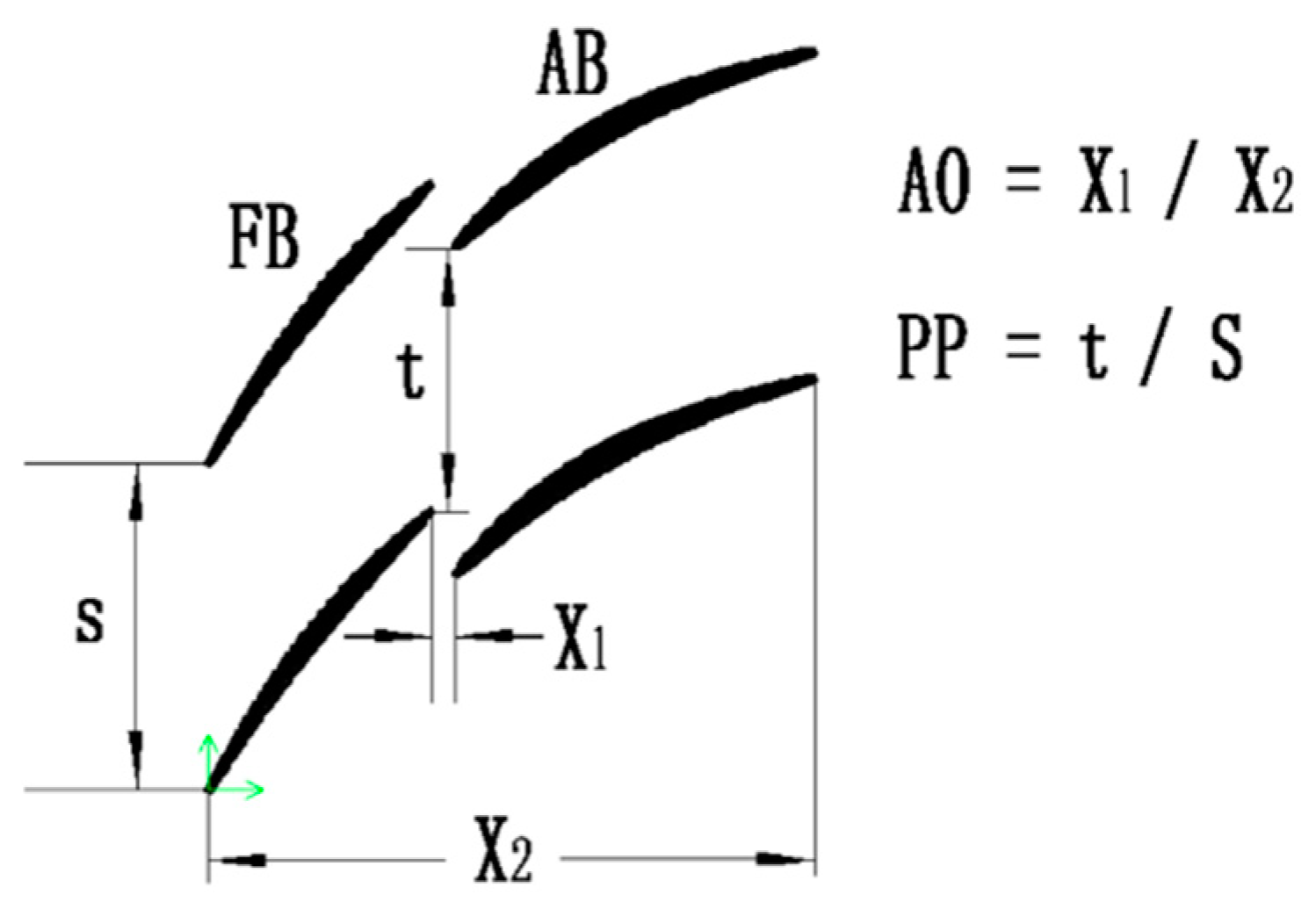
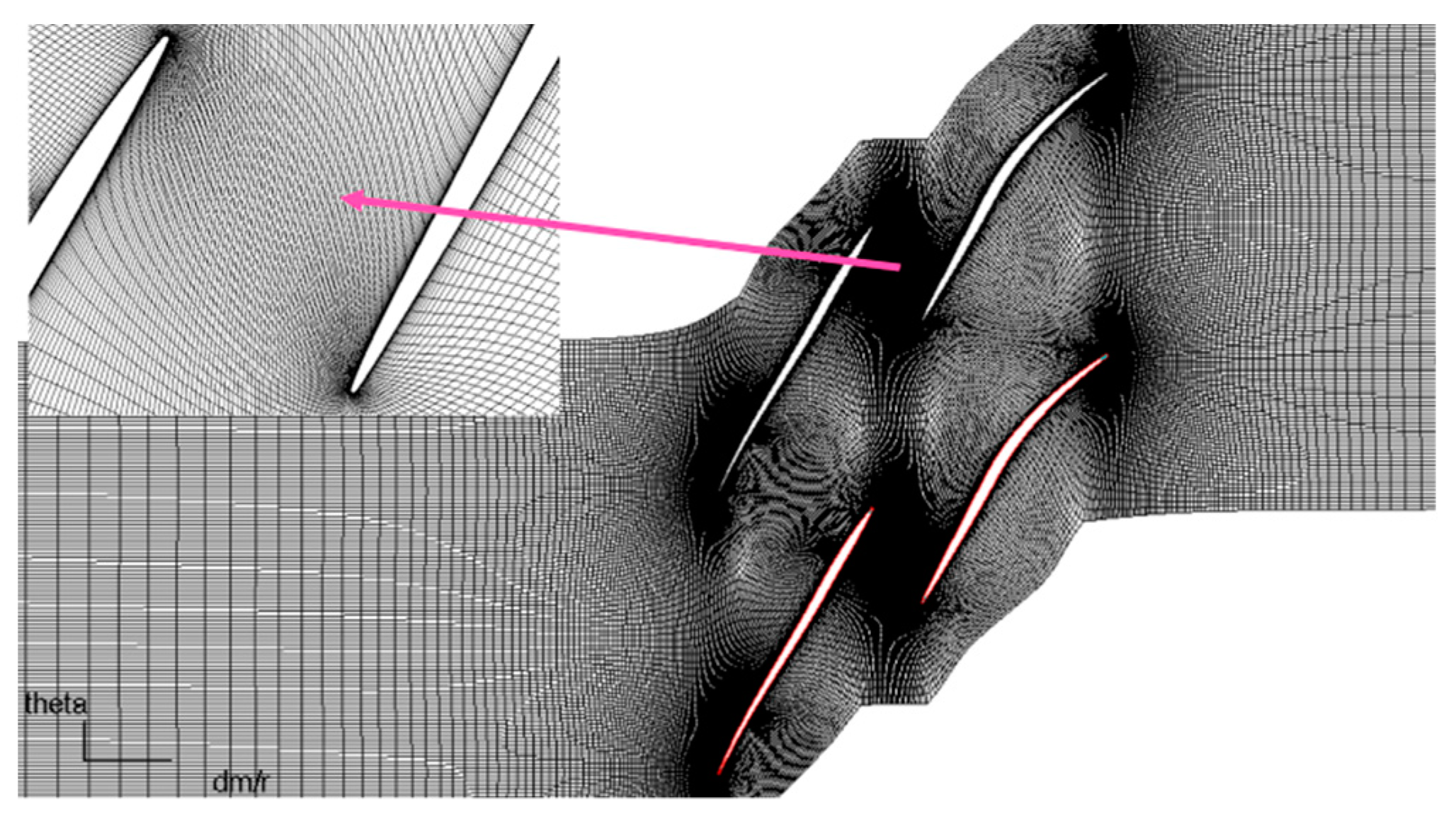



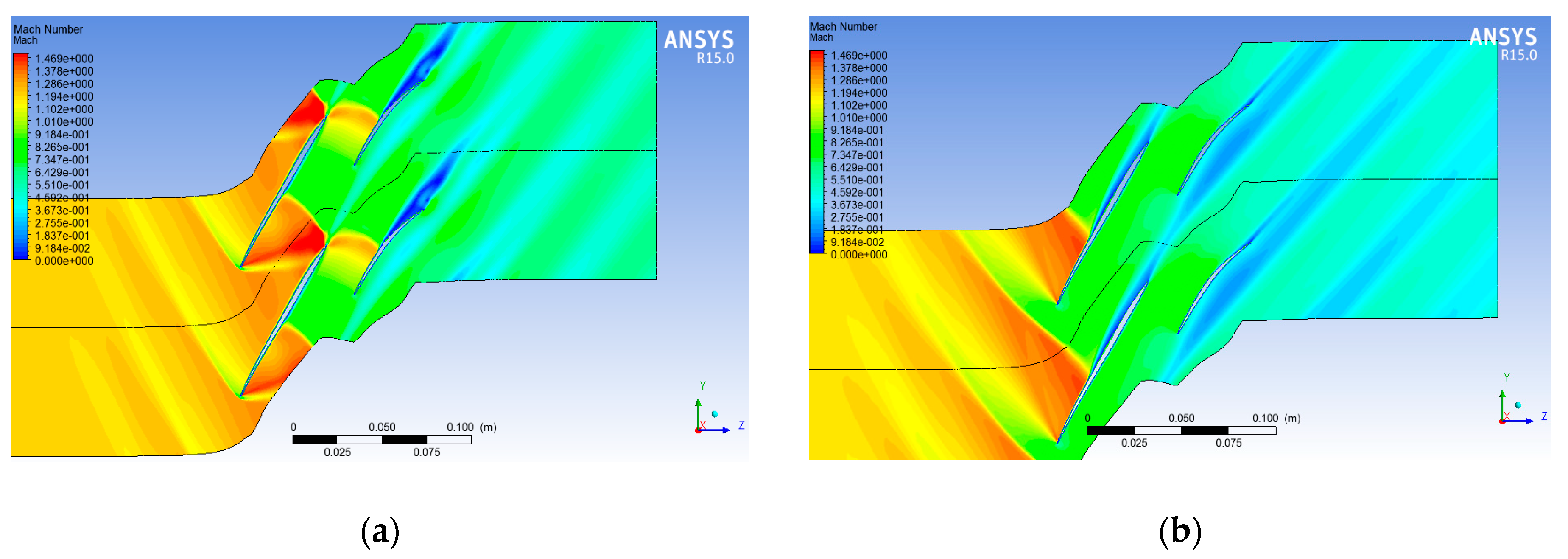
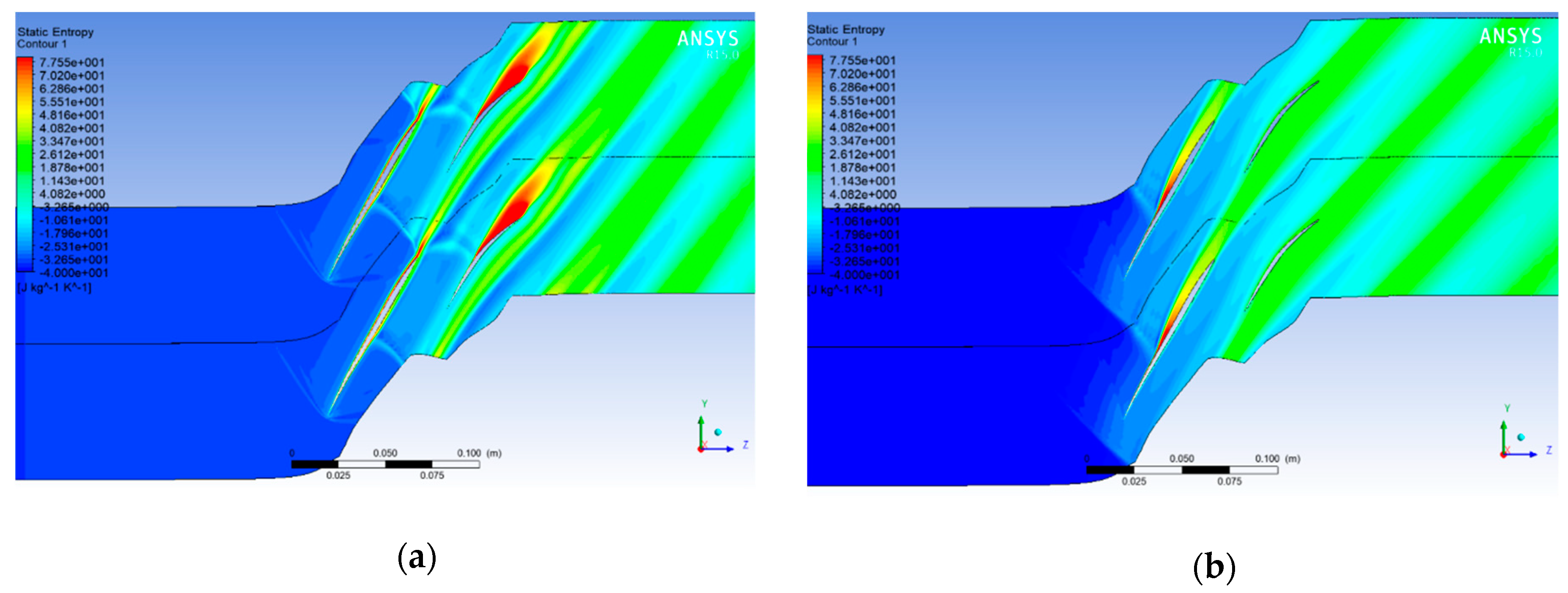
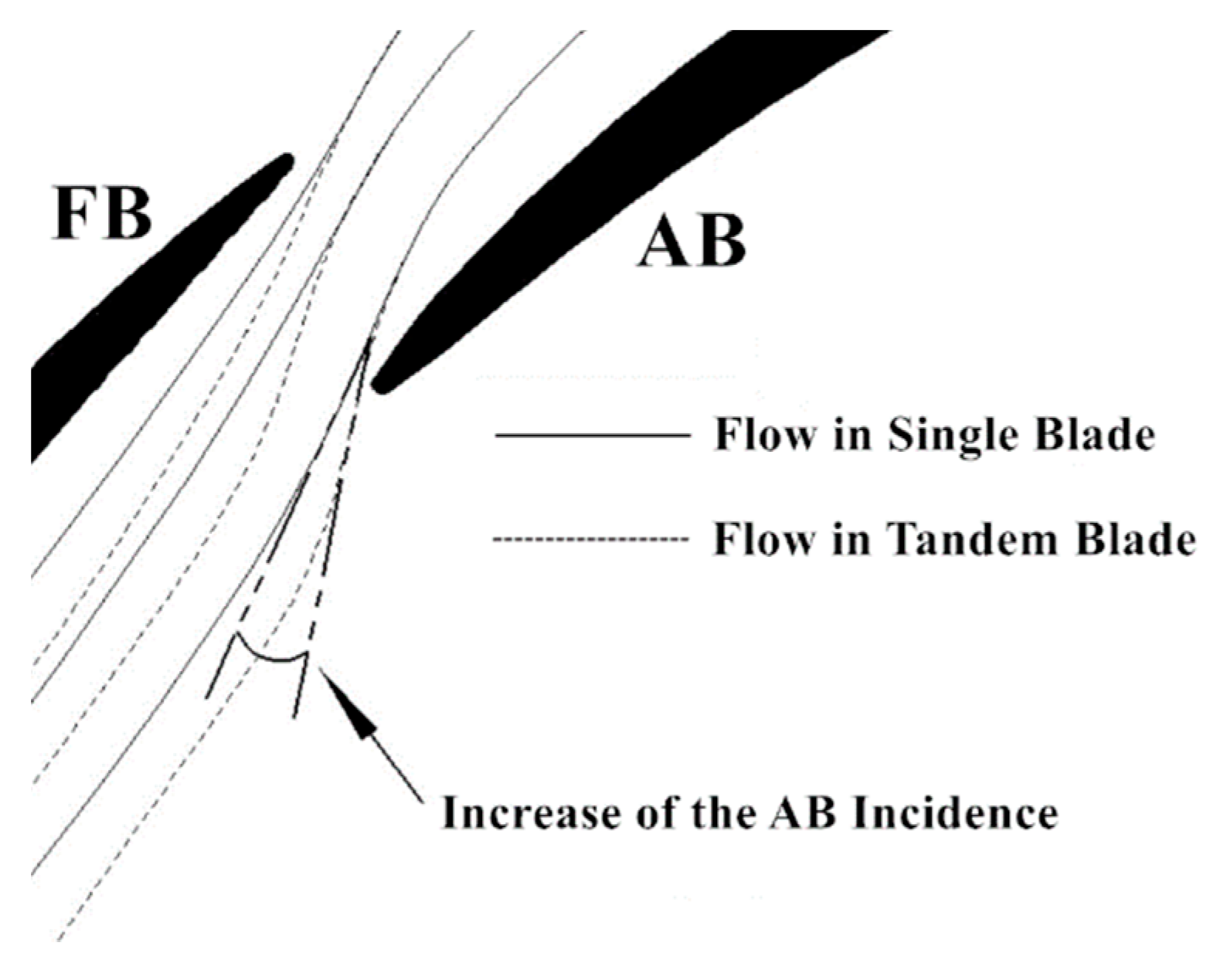


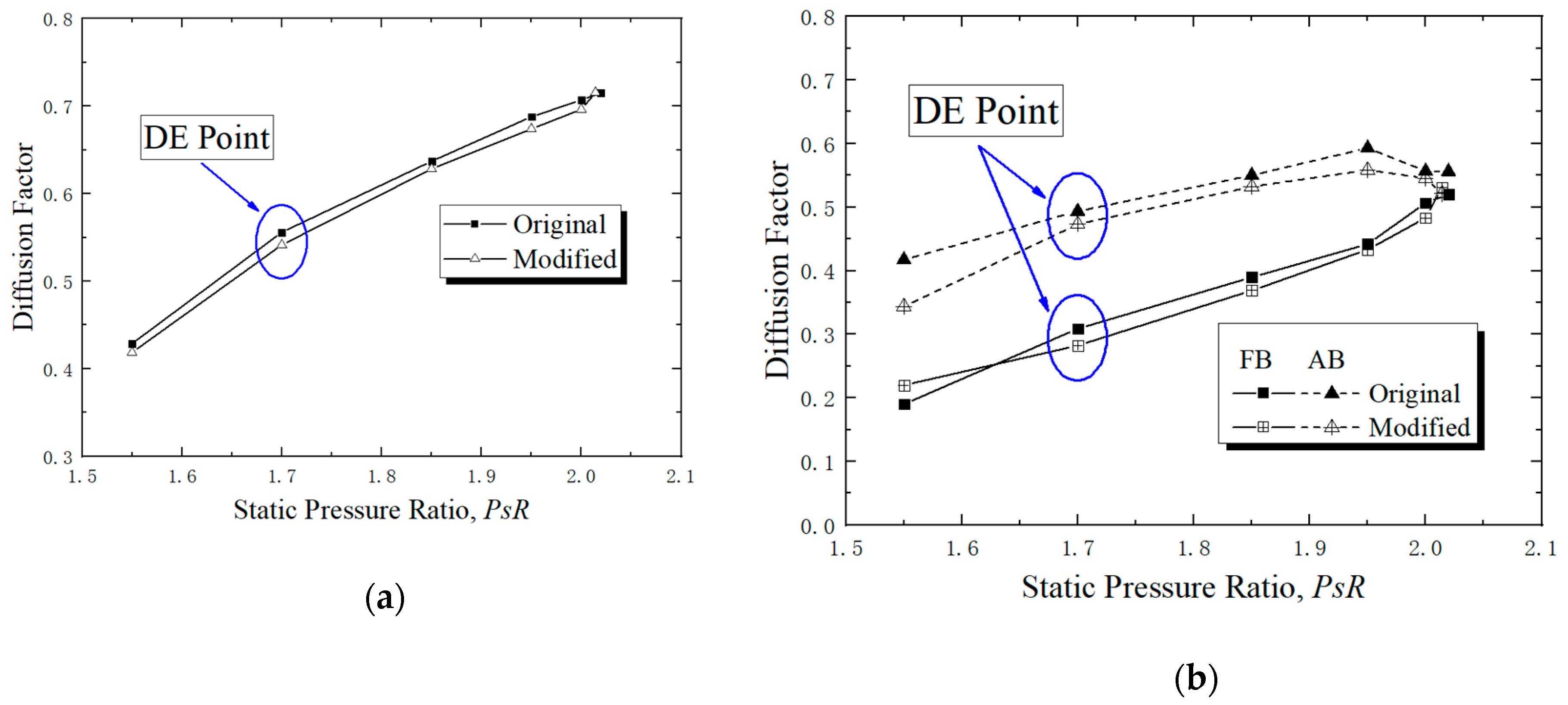
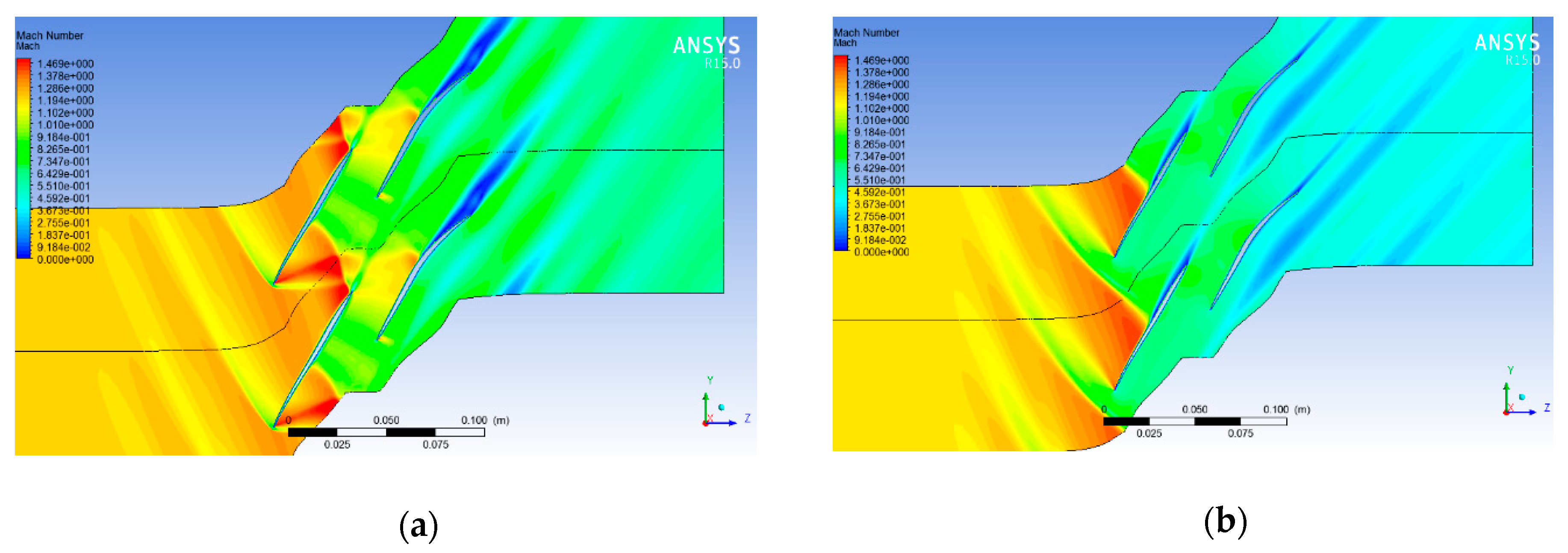
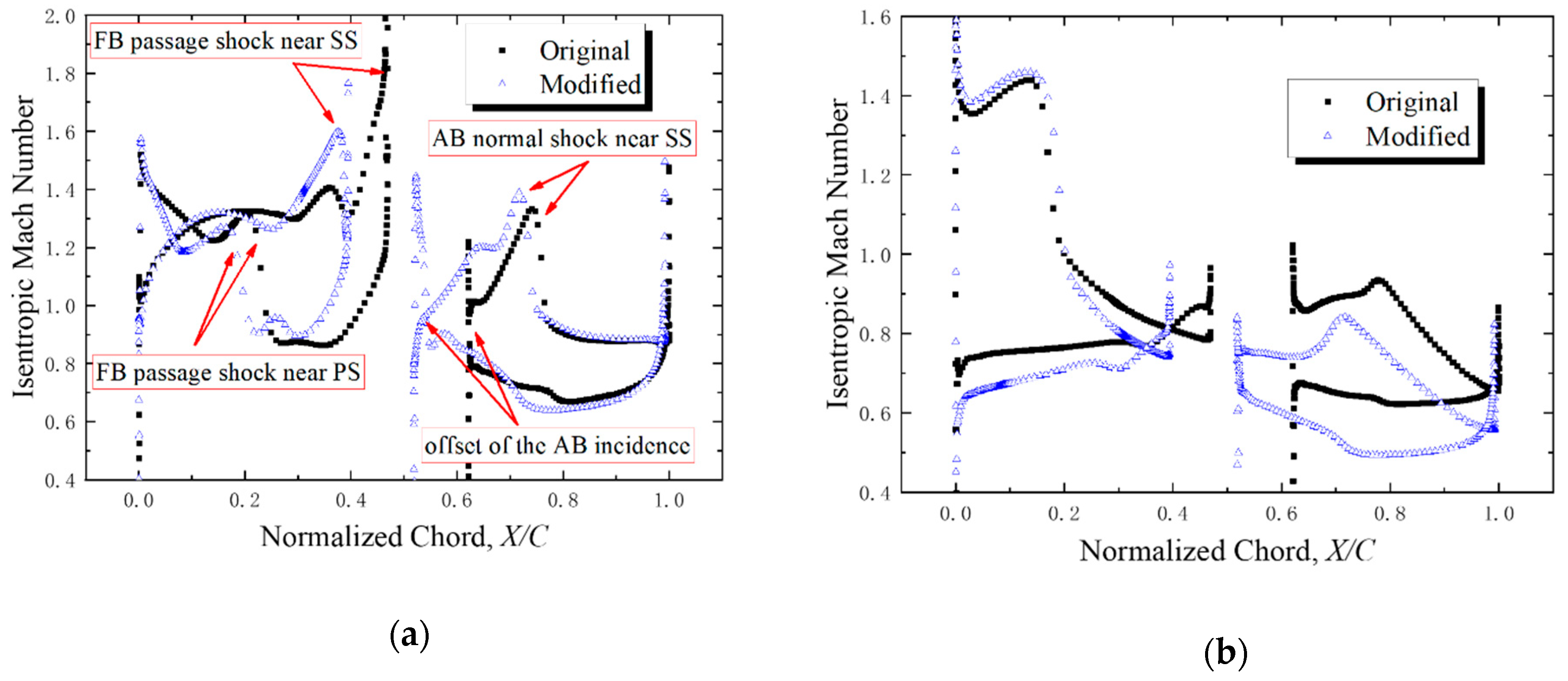
| Abbreviation | Explanation |
|---|---|
| FB | Forward blade |
| AB | Aft blade |
| LE | Leading edge |
| TE | Trailing edge |
| PS | Pressure side |
| SS | Suction side |
| DE | Design point |
| NS | Near stall point |
| S | Pitch [mm] |
| C | Chord [mm] |
| σ | Solidity |
| t | Pitch space between FB TE and AB LE [mm] |
| P11 | Static pressure at FB inlet [Pa] |
| P22 | Static pressure at AB outlet [Pa] |
| Pt11 | Total pressure at FB inlet [Pa] |
| Pt12 | Total pressure at FB outlet [Pa] |
| Pt11 | Total pressure at AB inlet [Pa] |
| Pt12 | Total pressure at AB outlet [Pa] |
| Greek Symbols | Explanation |
|---|---|
| ωTotal | Total pressure loss of tandem blade, |
| ωFB | Total pressure loss coefficient of FB, |
| PsR | Static pressure ratio of tandem blade, |
| β11 | FB inflow angle relative to axial coordinate |
| β21 | AB inflow angle relative to axial coordinate |
| κ11 | FB metal angle relative to axial coordinate |
| κ21 | AB metal angle relative to axial coordinate |
| i | Incidence of tandem blade, β11-κ11 |
| iAB | Incidence of AB, β21-κ21 |
| FB | AB | Tandem | |
|---|---|---|---|
| S (mm) | 72.6 | 72.6 | 78.1 |
| C (mm) | 97.4 | 61.4 | 186.6 |
| Inlet Metal Angle (°) | 66.2 | 57.1 | - |
| Outlet Metal Angle (°) | 62.4 | 35.4 | - |
| Installation Angle (°) | 62.1 | 51.3 | 45.8 |
| Solidity | 1.34 | 0.87 | 2.39 |
| AO | - | - | −0.15 |
| PP | - | - | 0.38 |
| Case1 | Case2 | Case3 | Case4 | Case5 | |
|---|---|---|---|---|---|
| Number of grids (× 103) | 330 | 405 | 470 | 530 | 590 |
| ωTotal | 0.2068 | 0.2122 | 0.2148 | 0.2151 | 0.2150 |
| Incidence range (°) | 1.9490 | 1.9408 | 1.9366 | 1.9362 | 1.9363 |
© 2020 by the authors. Licensee MDPI, Basel, Switzerland. This article is an open access article distributed under the terms and conditions of the Creative Commons Attribution (CC BY) license (http://creativecommons.org/licenses/by/4.0/).
Share and Cite
Tao, Y.; Wu, Y.; Yu, X.; Liu, B. Analysis of Flow Characteristic of Transonic Tandem Rotor Airfoil and Its Optimization. Appl. Sci. 2020, 10, 5569. https://doi.org/10.3390/app10165569
Tao Y, Wu Y, Yu X, Liu B. Analysis of Flow Characteristic of Transonic Tandem Rotor Airfoil and Its Optimization. Applied Sciences. 2020; 10(16):5569. https://doi.org/10.3390/app10165569
Chicago/Turabian StyleTao, Yuan, Yifei Wu, Xianjun Yu, and Baojie Liu. 2020. "Analysis of Flow Characteristic of Transonic Tandem Rotor Airfoil and Its Optimization" Applied Sciences 10, no. 16: 5569. https://doi.org/10.3390/app10165569






